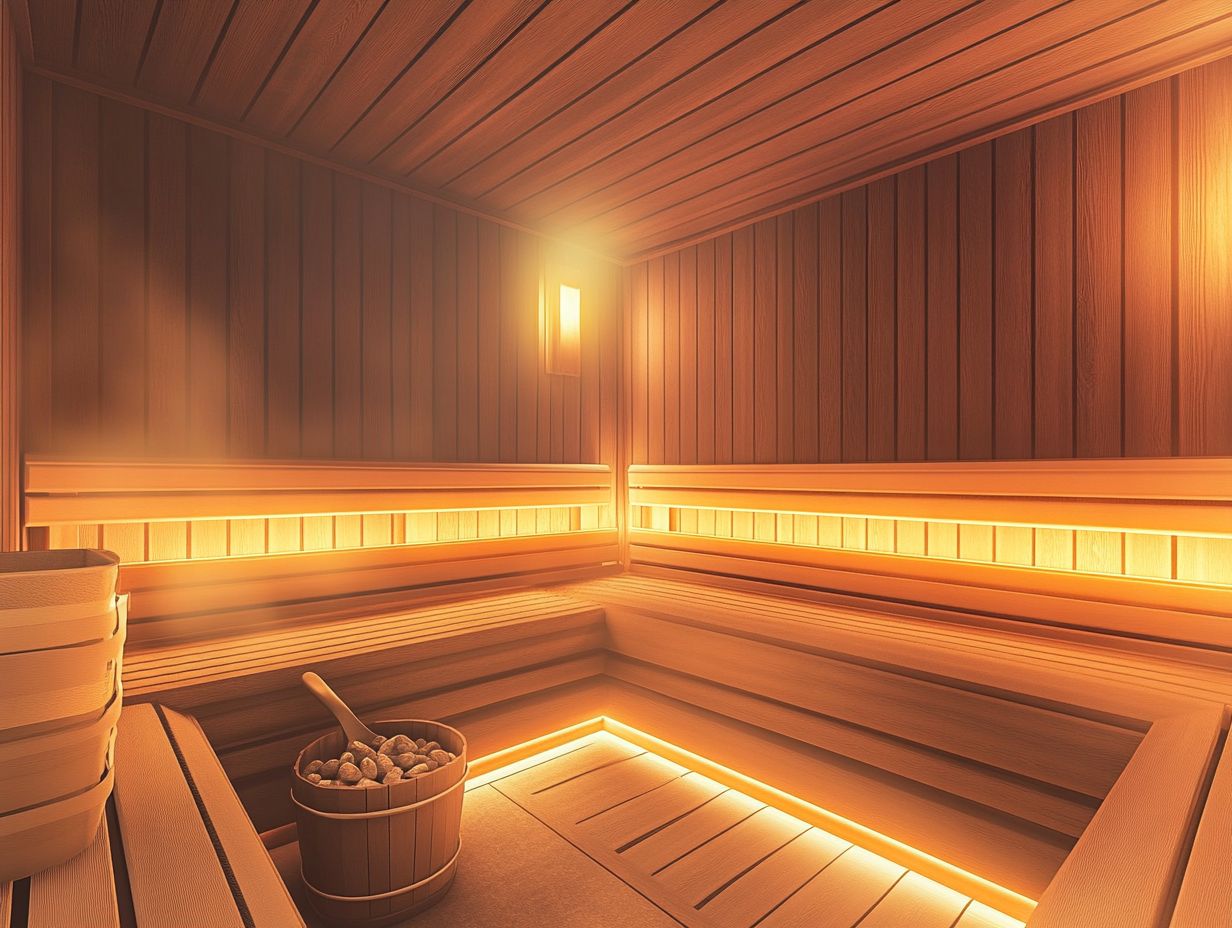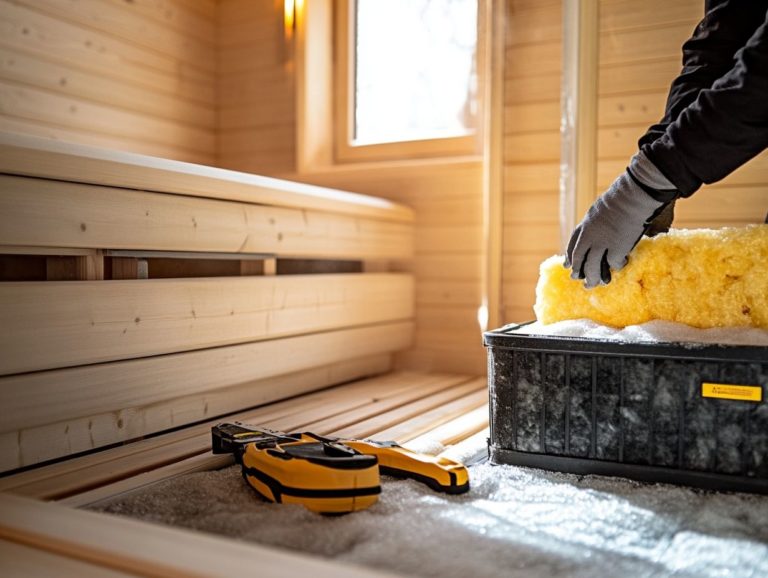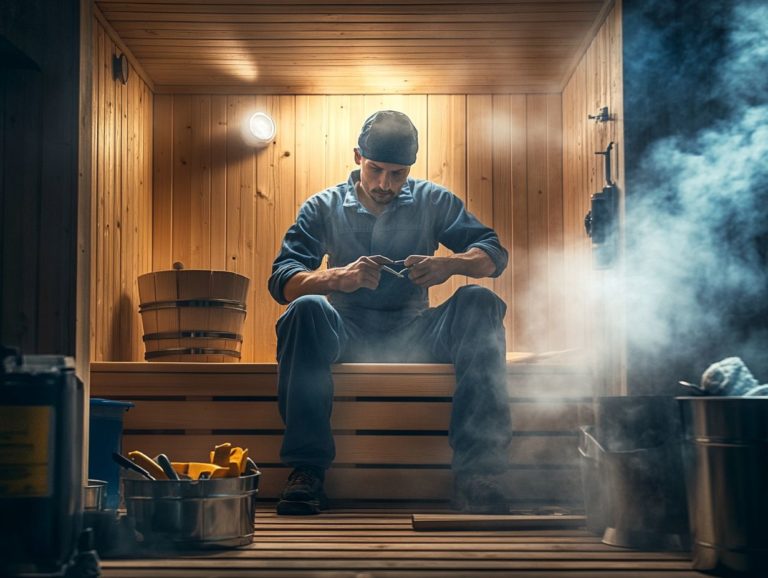Keeping Your Sauna Dry: Best Practices
Maintaining a dry sauna is crucial for both its functionality and your overall wellness. A properly dry environment elevates the sauna experience, fostering relaxation and reaping health benefits while safeguarding against costly damage in the long run. Using quality cleaning agents and special cleaners can further enhance your sauna’s maintenance.
Discover why keeping your sauna dry is vital for an amazing experience! This guide highlights prevalent moisture issues and provides practical maintenance tips to tackle humidity effectively. It also emphasizes the importance of using wood preservatives and proper cleaning procedures.
You ll find best practices for ventilation and insulation, along with a comparison of traditional and infrared options.
Immerse yourself in this information to ensure your sauna remains a rejuvenating retreat.
Contents
- Key Takeaways:
- The Importance of Keeping Your Sauna Dry
- Common Causes of Moisture in Saunas
- Preventing Moisture Buildup
- Best Practices for Keeping Your Sauna Dry
- Alternative Options for Dry Saunas
- Frequently Asked Questions
- What are the best practices for keeping my sauna dry, including proper maintenance checks and using suitable cleaning methods?
- Why is it important to keep my sauna dry?
- How often should I clean my sauna to maintain dryness?
- Can a dehumidifier be used in a sauna?
- What should I do if my sauna becomes damp?
- Are there any natural remedies for keeping a sauna dry?
Key Takeaways:

- Regular maintenance and cleaning of your sauna, including the sauna walls and benches, is crucial in preventing moisture build-up and potential damage.
- Proper ventilation and insulation are key factors in maintaining a dry sauna environment, ensuring optimal temperature and humidity levels.
- Traditional and infrared saunas both offer dry heat, but infrared saunas may be a more efficient option for sauna enthusiasts with moisture concerns.
The Importance of Keeping Your Sauna Dry
Keeping your sauna dry is essential for a safe and enjoyable experience. Moisture on wooden surfaces, such as cedar and pine, can lead to decay and damage, undermining both the aesthetic appeal and the structural integrity of your sauna.
In Finnish culture, where sauna ownership is a cherished tradition, maintaining a dry environment is of utmost importance. Using wood treated for durability can enhance this experience. By conducting regular maintenance checks and managing humidity and temperature levels, you can significantly extend the life of the timber. This ensures your sauna remains a true sanctuary for relaxation and rejuvenation, especially when combined with effective wood treatment.
Benefits of a Dry Sauna
A dry sauna offers a wealth of benefits that elevate your overall sauna experience, making it an invaluable addition to your home or outdoor space, especially for those interested in sauna design.
These advantages go far beyond simple relaxation; regular use of a dry sauna can significantly enhance your heart health through improved circulation. By increasing your heart rate and improving blood flow, it effectively mimics the benefits of moderate exercise, which is crucial for overall health. This boost in circulation can help lower the risk of heart disease and enhance your overall cardiovascular fitness.
Relaxing in a dry sauna is also a great way to relieve stress, fostering mental clarity and emotional well-being, especially when enhanced with essential oils. To truly enjoy these benefits, proper maintenance, including regular cleaning with a soft brush and disinfectants, is crucial for keeping the sauna environment dry. This not only prolongs its lifespan but also maximizes its health advantages, particularly when utilizing protective substances like wood oils.
Manage the temperature and humidity carefully. Using a heater with precise controls can enhance your experience, allowing you to fully immerse yourself in the uniquely soothing atmosphere that a dry sauna provides.
Common Causes of Moisture in Saunas
Understanding the common causes of moisture in saunas is crucial for implementing effective maintenance and prevention strategies. This safeguards the integrity of wooden surfaces, particularly for different wood species used in sauna construction.
By recognizing these factors, you can take proactive steps to ensure your sauna remains in optimal condition, enhancing both its longevity and your overall sauna experience.
Take these simple steps today to ensure your sauna remains your favorite retreat!
Identifying and Addressing Leaks and Humidity

Identifying and fixing leaks and humidity in your sauna is essential. It prevents long-term damage to wooden surfaces and keeps you and your guests safe!
Frequent moisture buildup can foster mold growth and lead to deterioration. It’s crucial to recognize early signs and tackle them with effective cleaning procedures. Look out for water spots or condensation on the walls. The feel of the air is another indicator excessive dampness often signals underlying sauna maintenance issues.
Regularly inspect all seals and joints, especially around doors and windows. This will help you catch issues before they escalate, ensuring the longevity of your sauna’s wooden components.
Make a habit of cleaning surfaces with a suitable antimicrobial solution, which helps kill harmful bacteria, and thoroughly drying them afterward. This is a wise strategy, especially when using cleaning agents designed for wooden surfaces.
Conduct periodic inspections of your sauna s ventilation system to enhance airflow. This is vital for maintaining optimal humidity levels and preventing leaks. Taking these proactive steps ensures your sauna remains a sanctuary for relaxation!
Preventing Moisture Buildup
Preventing moisture buildup is a must for the longevity of your sauna and the preservation of wooden surfaces. This ensures you can enjoy a comfortable sauna experience without worry!
By taking proactive measures, such as using a protective layer of wood oils, you not only protect your investment but also enhance the overall ambience and functionality of your retreat.
Effective Maintenance and Cleaning Tips
Effective maintenance and cleaning tips are crucial for preserving the quality of your sauna’s wooden surfaces, such as sauna benches.
A well-cared-for sauna exudes an inviting ambiance, especially with the use of essential oils. It also fosters a healthier environment for you and others. Routinely check for moisture buildup and any contaminants, including dirt and stains, that could impact the wood.
Opt for specialized cedar or pine cleaners, like Supi Saunapesu from Tikkurila. These products are specifically formulated to protect and preserve the natural oils and grains of the wood.
Using a quality wood treatment method, such as a natural oil or sealant, will help repel water and prevent damage, especially when using products from Thermory.
Inspect regularly for signs of wear and make timely applications of protective substances like wood oils. This diligence ensures you can enjoy its benefits for many years to come!
Best Practices for Keeping Your Sauna Dry
By implementing the best practices for maintaining a dry sauna, you will enhance your experience as a sauna owner. This also extends the lifespan of the wooden surfaces, including sauna benches and walls.
Proper Ventilation and Insulation

Proper ventilation and insulation are essential for maintaining the ideal conditions in your dry sauna. They play important roles in humidity control and temperature regulation, which are crucial for your sauna experience.
When these elements are effectively implemented, they prevent excess moisture buildup, leading to an uncomfortable atmosphere and, over time, even structural damage to timber products. A well-ventilated sauna allows fresh air to circulate while limiting stagnant pockets, creating a harmonious environment that enhances your overall experience, particularly when paired with thoughtful sauna design.
Effective insulation retains heat more efficiently, minimizing the energy needed to maintain optimal warmth. This is crucial for eco-friendly sauna ownership. Not only does this synergy guarantee a comfortable and enjoyable sauna session, especially with the right heater, but it also safeguards the integrity of the space, promoting a healthier and longer-lasting sauna environment.
Recommended Temperature and Humidity Levels
Maintaining the right temperature and humidity levels is vital for optimizing your sauna experience and protecting the wooden surfaces from moisture damage, especially for different wood species.
A well-regulated sauna environment elevates your relaxation and offers significant health benefits, such as improved circulation and detoxification. These benefits can be enhanced with the use of essential oils. The ideal sauna temperature usually hovers between 150 F and 195 F, allowing you to bask in the invigorating heat without feeling overwhelmed, particularly in outdoor saunas.
Keeping humidity levels between 10% and 20% is essential, as this directly impacts your experience and the longevity of the wood’s structural integrity. Higher humidity can amplify the heat sensation, making it feel more intense, while lower humidity enhances comfort and enables longer sessions in a well-maintained sauna.
Regularly monitoring these factors ensures the longevity of your sauna’s construction while contributing to a safe and enjoyable experience.
Alternative Options for Dry Saunas
Exploring alternative options for dry saunas can elevate your sauna ownership experience, offering a variety of unique designs and functionalities, including options for thermally modified wood.
Comparing Traditional and Infrared Saunas
When comparing traditional and infrared saunas, you’ll uncover unique approaches to moisture control and the overall sauna experience, particularly in relation to sauna maintenance.
Traditional saunas heat things up, typically reaching temperatures between 150 F and 195 F. They use steam to create a humid environment that encourages perspiration while necessitating careful cleaning procedures. This humidity creates a soothing atmosphere, enhancing relaxation and enveloping you in warmth.
In contrast, infrared saunas utilize infrared heaters to emit radiant heat, often operating at lower temperatures of 120 F to 140 F. Experience the invigorating dry heat that rejuvenates your body while promoting detoxification, especially with the right wood species.
Maintaining traditional saunas usually involves regular inspections and careful management of moisture levels to prevent unwanted mold, using specialized cleaning agents. Infrared options tend to require less frequent servicing, making them a convenient choice for many enthusiasts.
Ultimately, both types offer an enriching sauna experience, showcasing different sauna designs that cater to your relaxation and wellness needs.

Frequently Asked Questions

What are the best practices for keeping my sauna dry, including proper maintenance checks and using suitable cleaning methods?
- Regularly clean and wipe down surfaces.
- Use a dehumidifier.
- Keep the door closed when not in use.
- Properly ventilate the room.
Why is it important to keep my sauna dry?
Keeping your sauna dry is essential for your health and enjoyment! It prevents mold and bacteria growth, ensuring a safe and pleasant experience.
How often should I clean my sauna to maintain dryness?
Clean your sauna at least once a week to keep it dry. If you use it often, consider cleaning it more frequently.
Can a dehumidifier be used in a sauna?
Yes, you can use a dehumidifier in your sauna. This device removes moisture from the air; just ensure it s designed for sauna use and follow the instructions carefully.
What should I do if my sauna becomes damp?
If your sauna becomes damp, increase the ventilation and use a dehumidifier. Also, check for any leaks in the room or sauna itself.
Are there any natural remedies for keeping a sauna dry?
Yes! Try placing bowls of salt or rice in the room to absorb moisture. You can also use essential oils that help fight germs and mold.
Additionally, silica gel packets can help soak up excess moisture.






